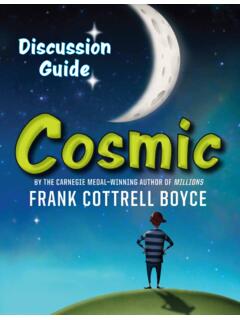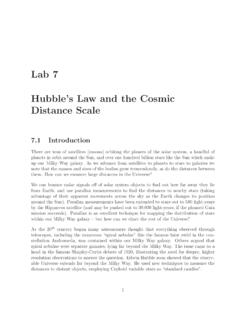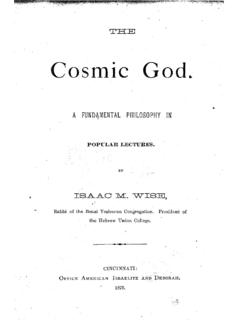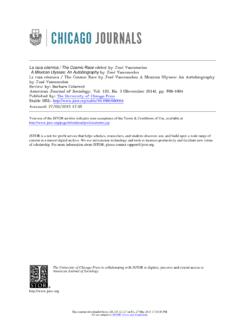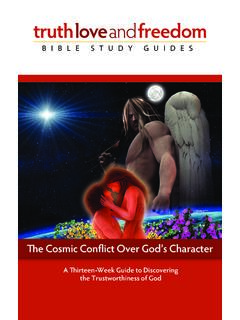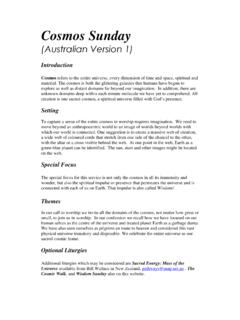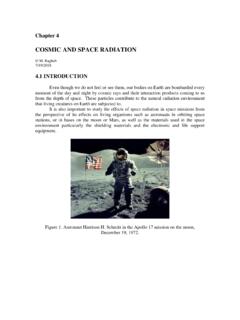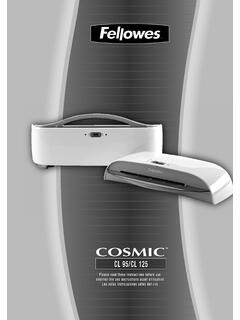Transcription of THE COSMIC MICROWAVE BACKGROUND …
1 THE COSMIC MICROWAVE BACKGROUNDRADIATIONB. Winstein Center for Cosmological PhysicsThe University of ChicagoChicago, Illinois, 60637 ABSTRACTT hese lectures will attempt to convey the excitement and promise instudies of the MICROWAVE radiation left over from the early are aimed at an audience of experimental high energy first lecture will concentrate on how the radiation is charac-terized, how it and its anisotropies are generated, and the physics thatit second lecture will concentrate on the techniques that are usedin experiments, addressing the question of how such small signals canbe detected so precisely in a regime of extremely low third and final lecture will present the main thrusts in thisfield as foreseen for the coming decade. Supported by the NSF1 IntroductionBy studying the COSMIC MICROWAVE BACKGROUND radiation field, cosmologists areuncovering extraordinary information about the early universe. Cosmology is ina very exciting and data-driven stage right now and arguably studies of the CMBhave been the most lectures will attempt to convey the excitement and promise to highenergy physics experimentalists.
2 The emphasis will be on experiment: how mea-surements are made and by what techniques. We will also need to understandsome of the basic concepts to fully appreciate the science. The presentation willbe more pedagogical than inclusive, as appropriate for the classroom. In particu-lar, I apologize in advance to my new colleagues for an incomplete reference list,hoping that they will remember when they were first learning the people have been of great help in the preparation of these lectures;their names are given in the Lecture 1We begin with a discussion of the very early stages of this field. We discuss theorigins of the radiation , its black-body nature, how its anisotropies are generatedand characterized, and how the hypothesis of Inflation accounts for the observedregularities. We close this section with a summary of the physics addressed bythe CMB, using the recent WMAP results as the best The Early YearsAs is well known, the radiation was discovered in 1965 by Penzias Wilson.
3 It was a serendipitous discovery: the scientists were not explicitlylooking for extragalactic radiation , let alone radiation of such import, but ratherwere led to the unavoidable conclusion that there was an isotropic source of noise in their detectors coming from the 1 shows a rough plot of the number of articles published per yearsince the initial discovery. Today there are approximately 150 experimentalistsworking in this area. WMAP is having a great influence on the field: most of thepublications in 2003 treat WMAP data in one form or another. It is interesting05010015020025030035019651969 19731977198119851989199319972001 Column 1 Figure 1:Approximate Number of Papers on the CMB per Yearto note that this publication profile is similar to that for papers published on first measurement was made at a wavelength of approximately 10 reported temperature was:T= ( 1)K.(1)This measurement was way off the peak of the radiation which is more like 3 points out an important feature of the spectrum of black body radiation :if you know the flux atanyknown frequency, that determines the temperatureof the radiation field.
4 Figure 2 gives the flux of detected radiation (in watts persquare meter per Hz per steradian) vs. wavelength for a variety of temperatures,nicely displaying the linear increase in detected radiation vs. temperature at lowfrequencies (the Raleigh-Jeans part of the spectrum) and the displacement of thepeak to higher frequencies as the temperature it was thought that the radiation might be reemission of star light byinterstellar dust; this was ruled out by studies of the spectrum. Another possibilitywas that it was emission from radio galaxies but this hypothesis was discardedbecause it was known that there were not enough of these galaxies to reproducethe smoothness of the 2:The Black Body is the flux distribution for1K, 10K, 100K, .. to 1010K. The Measured Flux at any temperature uniquelydetermines the temperature. (Plot courtesy of M. Hedman)Key in the interpretation was whether the radiation indeed was isotropic andwhether it really followed a blackbody spectrum.
5 By 1967, Partridge and Wilkin-son had shown over large regions of the sky, that: TT= (1 3) 10 3.(2)In 1967 a Princeton group made the first measurement at a different frequency;this was crucial in verifying the black body nature of the radiation . Figure 3 showsthe two measurements on top of the expected curve. Also shown are measurementsof the galactic BACKGROUND at several different wavelengths, showing that it has avery different spectral index from that for a black important confirmation came from a study of the pattern of ab-sorption lines in interstellar CN molecules. It turns out that there are a pair oflow-lying rotational states of this molecule. The first is excited with mm ra-diation and the second can be reached from the first state with mm the observed relative population of these states, it was determined that themolecules were bathed in a sea of radiation with a temperature ofT= ( )K.(3)Figure 3:The First Confirmation at 3 flux from the original mea-surement together with the first confirmation at 3 cm are shown.
6 Also shown aremeasurements of the galactic foreground (which was then called a BACKGROUND ),showing its different (non-black body) spectral shape. (Figure from )This was a most remarkable result for at least two reasons: is showed for the firsttime that this new radiation extended beyond the solar system; and this discoverywas made in 1941!Today s spectral information on the CMB is shown in figure 4. The shortwave-length measurements are dominated by the FIRAS instrument on the COBE satellite- the errors on these points are FAR smaller than the points other measurements at longer wavelengths contribute to making this themost accurately measured The Origin of the RadiationThe radiation we see today came from an era when the Universe was hot. Whenit had a temperatureT>13ev, protons, electrons and photons were the mainconstituents of a plasma in equilibrium; the expansion of the universe cooled theplasma to where hydrogen atoms formed (called the era of recombination, eventhough the atomic constituents had never been combined prior).
7 The parameters of this era are the following:The CMB Spectrum TodayFigure 4:The Planck Spectrum of the CMB. T 300K ev z= 1088 2 z= 195 2 t= (379 8)KY Ttoday= photons that we see today were then emitted when the universe was some1100 times smaller than today, from a surface with a thickness of about 20%,about 380 thousand years after the Big-Bang. The (impressively small) errors onthe values are taken from the recent WMAP for second order effects (to be discussed in the 3rd lecture), photonscome to us from this surface of last scattering with no further interactions, savethe red-shifting due to the expansion. As such they provide an important andunique view of the universe at a well defined time, indeed the earliest such isn t immediately obvious how a view of the Universe, even a very precise view,when it had a temperature as less than 1 ev can yield unique information aboutits origins, or at least its properties when the particle energies were far relics come from substantially earlier eras.
8 Neutrinos, because of theirmuch lower cross-section, decoupled minutes after the Big-Bang but the prospectsfor their detection is slim. And the protons in our bones were first created at aneven much earlier era but have had an extremely complicated history so that onlytheir abundance hints at anything primordial. Why (and how good) a Black Body?An important question is why the radiation we see today is so precisely thermaland how well we can limit non-thermal (re)combination, Thomson scattering dominates the interactions be-tween the electrons and photons. This (elastic) process will change photon direc-tions but not the number of photons. The latter needs to change when there isa non-thermal distribution of injected energy but Thomson scattering can not beresponsible for the restoration of equilibrium when, for example,e+e annihilationoccurred atz relevant processes that do change photon number are Bremstrahhlung andCompton scattering; these processes would take an essentially arbitraryspectrumatz 106and thermalize it.
9 When there is not enough time for photonnumbers to shift, the spectrum looks like a black-body but with a linear shift tohigher frequencies. The fractional shift is parameterized by the photon number distribution for a pure blackbody (the Planck distribution)is governed by the factor:1eh kT 1(4)whereas the number density for particles in kinetic equilibrium , where there areno processes changing the number of photons (the Bose-Einstein distribution), isgoverned by the factor:1eh kT+ 1(5)where is the chemical spectrum shown in figure 4 fits a blackbody with residuals less than 50ppm. The corresponding limits on the spectral distortions are:y<15 10 6(6)and| |<9 10 5.(7)For an energy release Uwith 105<z<3 106, a Planck Spectrum becomesBose-Einstein and from the limit on the size of the chemical potential the limit2for energy injection during this era is: UU= .(8)while an energy release withz<105causes a spectral shift and: UU= 4y.(9)Thus the purity of the black body spectrum lends great confidence that nounusual or unexpected energy injections, at the level of a few 10 5of the totalenergy in the photons occurred later thanz 106or later than a few monthsafter the AnisotropiesFrom the very beginning, cosmologists began searching for anisotropies in thebackground radiation : were the radiation pattern, and therefore the associatedmatter density, precisely uniform, then it would have been difficult to explain theorigin of the obvious anisotropy in the matter distribution the first anisotropy was seen in the late 1970 s, that arising fromthe motion of the sun through the MICROWAVE radiation field, creating a dipoleof magnitude 10 3.
10 But the true (primordial) anisotropy was detected first bythe COBE satellite in 1992. The detector had a beam of 7 degrees so theanisotropies could only be detected on scales larger than this. Regions this farseparated were never in causal contact with each other, at least in the standardbig-bang model so the detected anisotropies, of the order of 10 5or 30 K, needto be considered as initial 5 shows the path of the radiation since decoupling, indicating that thecausal horizon is of order to the present, the recent map of the radiation field by the WMAP satellite is shown in Figure 6. This is a beautiful achievement, the precise whole-sky determination of the temperature with a spatial resolution of about Characterization of the Temperature FieldCosmologists have developed techniques for characterizing the temperature fieldwhich we will now describe. First, let s denote the temperatureTat the surfaceFigure 5:Schematic of the path of the the Big-Bang (pre-inflationary) model, patches of the CMB sky observed today that are more thanabout 20apart were never in causal 1.
